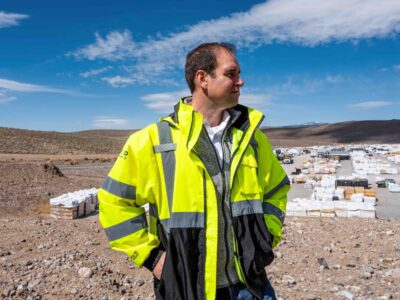(Bloomberg) —
Goldman Sachs Group Inc. is working on its first ever deals in a corner of the debt market that’s increasingly being touted as a way for struggling emerging markets to attract risk-averse private capital.
John Greenwood, co-head of Americas structured finance at Goldman in New York, said he and his team are now “looking at a number of debt-for-nature swaps” in Latin America. The goal is to finalize the deals next year, he said in an interview.
The products represent a “really innovative way” for a country to cut its debt burden while stepping up commitments to the environment, Greenwood said. “That is important and will be a trend that we continue to see.”
Goldman is the latest major bank to explore such swaps, which represent one of the fastest growing areas of so-called blended finance. The funding construction, which is dominating finance talks at the COP28 climate summit in Dubai, is supposed to make it more attractive for private capital to move into high-risk markets, thanks to backstops provided by public institutions such as multilateral development banks.
Wall Street’s growing interest in such deals coincides with new developments in the wider infrastructure around the market. On Monday, a group of eight international organizations and development finance institutions said they plan to support the market for nature-linked sovereign financing as part of a new global effort.
Ilan Goldfajn, president of the Inter-American Development Bank — one of the group of eight — said the world is now “at a critical juncture where innovative finance will be vital in helping countries access the needed resources.”
Ramzi Issa, who now oversees global structured credit and sustainable credit products at UBS Group AG after pioneering today’s market for debt-for-nature swaps at Credit Suisse, says the additional infrastructure from the public finance side is “broadening the toolkit” for private capital. “Now, there are many things possible that weren’t conceivable before,” he said on the sidelines of COP28 in Dubai.
At COP26 in Glasgow, the general assumption was that the energy transition in emerging markets was a problem for concessional finance, not for commercial finance. Now, “there’s a very deliberate effort to channel money into emerging markets and that is tangible,” said Nazmeera Moola, chief sustainability officer at South Africa-based asset manager Ninety One.
We’ve seen “some actual tangible progress” at COP28 “to catalyze more money into emerging markets,” she said. But there remain “many missing pieces.”
How to come up with the best blended finance models is an issue that has some of the finance industry’s most powerful and respected voices weighing in. Given an annual need of somewhere between $5 trillion and $10 trillion to address the challenges posed by global warming, it’s clear private capital will need to provide the lion’s share, but there has to be “a return on the money,” Ray Dalio, the founder of Bridgewater Associates said at the COP28 summit during a Bloomberg Green panel.Play Video
“There is a great possibility to make great money go into these initiatives, if they make it profitable.” Multilateral development banks have about $2 trillion at their disposal, while philanthropists have about $1 trillion, which is “a drop in the bucket,” Dalio said.
“The biggest pool of money is large institutional money — $200 trillion — that is the big pot of money,” he said. Today, “about 0.3% of that institutional money goes into climate in various forms of ecological investments,” he said.
Read More: Goldman Explores New Deal Structures for Emerging Markets
Coming up with viable blended finance constructions is “a must, not an option,” BlackRock Inc. Chief Executive Officer Larry Fink said at COP28 talks on Monday.
“We will not be able to mobilize enough private capital if we don’t do blended finance,” Fink said. “I urge all of us to think about how can we find a way to recreate the financial architecture so we can decarbonize the entire world safely, soundly and justly.”
Since Credit Suisse arranged the first debt-for-nature swaps involving private finance two years ago, some of the world’s biggest banks have started eyeing opportunities in a market that Barclays Plc estimates has the potential to reach $800 billion. The most recent deal was struck by Bank of America Corp. in August, in the form of a $500 million transaction for Gabon.
The instruments are designed to allow nations to refinance existing debt in exchange for commitments to use the savings on nature conservation. Though versions of such swaps have existed for several decades, it was Credit Suisse that came up with deal structures that made the swaps appealing to private investors such as pension funds.
So far, just four such swaps have been completed. Barbados, which is among nations to have tested the market, recently announced it is planning to seek a second deal, and a growing number of emerging markets is now considering such financing arrangements.
Last week, Kenya’s President William Ruto said his country was looking into selling sovereign green bonds and debt-for-nature swap deals to fund climate projects.
Before its takeover this year by UBS, Credit Suisse helped emerging-market governments replace about $2.3 billion of existing debt with roughly $1.2 billion of new financing tied to nature projects, according to Issa.Play Video
Debt-for-nature swaps have faced some criticism from some analysts, who argue their complexity and high fees make them an unnecessarily expensive way for struggling emerging markets to reorganize their debt.
Bloomberg has previously reported that banks expressing interest in entering the market for debt-for-nature swaps include Citigroup Inc., HSBC Holdings Plc, Standard Chartered Plc, as well as Barclays. The only two banks to have completed deals to date are Credit Suisse and BofA.
When it comes to addressing the climate crisis in the emerging markets, Goldman’s Greenwood said there’s no viable solution that doesn’t include private finance. But that will require experimenting with new financing structures, he said.
“The focus has got to be on innovation,” he said. “The debt-for-nature swap is one additional tool.”
(Updates with explainer on how debt-for-nature swaps work in 16th paragraph.)
© 2024 Bloomberg L.P.





